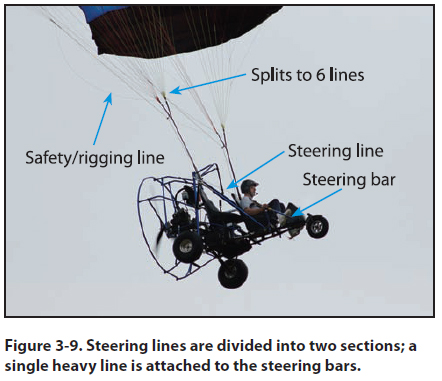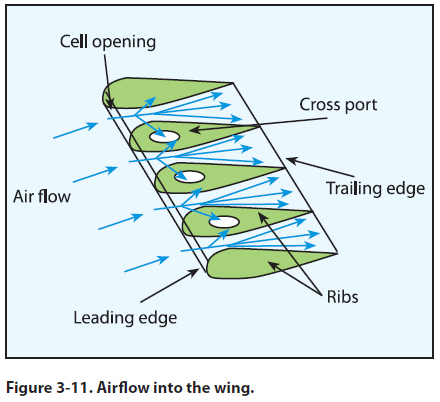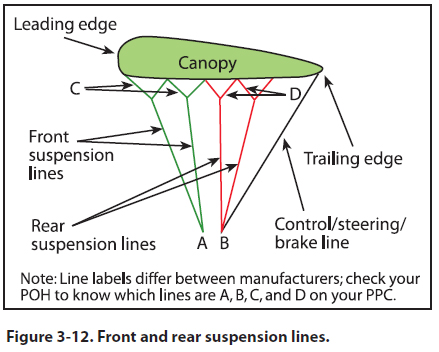|
Chapter 3 — Components and Systems
The Steering Bars
The steering bars are located just aft of the nosewheel
and mounted on each side of the aircraft; they move
forward and aft when the pilot applies foot pressure.
[Figure 3-8] The steering lines from the trailing
edge of the wing are attached to the outer ends of the
steering bars. (Some manufacturers have developed
a steering pedal system on their airframes, although
the steering lines function in the same manner.) The
main steering lines divide into various smaller lines,
which attach to multiple points on the trialing edge of
the wing. Pushing on either one of the steering bars
causes the steering lines to pull down the corresponding
surface of the trailing edge on the wing, creating
drag. This in turn slows that side of the wing and
banks the PPC into a turn.

Pushing both steering bars simultaneously causes
the steering lines to pull down equally on the trailing
edge, which causes two things to happen: it decreases
the powered parachute’s forward speed by increasing
the drag and it changes the shape of the wing, increasing angle of attack which increases lift. This
procedure, called “flaring” or “braking the wing” allows
the pilot to touch down at a slower rate of speed
and descent, thus creating a smoother landing, which
results in less wear and tear on the aircraft as a whole.
[Figure 3-9]

Wings and Components
The powered parachute wing is unique, as compared
to a fabric wing on an airplane, in that when it is not
inflated it loses its ability to produce lift. When a
powered parachute wing is inflated or pressurized, it
becomes semi-rigid and is capable of producing lift
and supporting a load. Rather than being bolted to the
fuselage like an airplane, the parachute wing is attached
to the cart by lines and cables which are known
as risers.
The wings are manufactured by attaching an upper
and lower section of skin to ribs. [Figure 3-10] The
ribs of the wing determine the airfoil shape. [Figure
3-11] The shape of a powered parachute wing
will change slightly when faced with different gross
weights, air pressures, and environmental conditions
such as moisture, air temperature and wind.
 
Different wing manufacturers use different fabric
treatments to render the fabric airtight, so the air that
enters the wing cannot escape through the fabric surface.
The top surface of the wing is generally treated
to help protect it from ultraviolet light and the elements.
Keeping the powered parachute wing out of
direct sunlight will increase its useful life.
If the fabric degrades and air is allowed to escape
through pores of the cloth, the overall flight performance
of the wing is greatly reduced. If your powered parachute wing should become too porous, more
groundspeed may be needed to pressurize the wing,
takeoff distance may increase, more RPM may be
required to hold altitude, and fuel consumption may
increase.
At first sight, the suspension lines on the powered
parachute wing might appear like an unorganized wad
of strings. On the contrary, each line has a distinct
purpose and each line has distinct properties. The suspension
lines are sometimes designated A through D
and differ between manufacturers; check your POH to
know the line labels for your PPC. [Figure 3-12] The
front suspension lines are located at the leading edge
and the steering lines connect to the trailing edge. The

suspension lines come together at a point where they
connect with the riser. (The risers are the connection
between the suspension lines and the cart.) Many
manufacturers color-code the wing suspension lines
to assist the pilot in their preflight inspection and layout
of the wing prior to inflation. [Figure 3-12]
Suspension lines must be constructed of very strong
materials, yet remain very small in profile to reduce
parasite drag. The most commonly used materials are
polyaramid and polyethelene, which are both carbon
based.
Kevlar® is a common polyaramid used for suspension
lines. Its properties render it extremely strong, as well
as resistant to stretching or shrinking, and it is not susceptible
to temperature changes. However, one critical
drawback of polyaramids is that they tend to kink
or knot when looped around. When polyaramids are
used to construct suspension lines, they are encased in
a skin of a terylene product, like Dacron® or a product
with similar properties. Polyethelene materials, such
as Spectra®, Dyneema® or Technora®, are very strong
as well as more flexible than polyaramids, which
makes them more durable under hard use. However,
polyethelene materials are more likely to stretch or
shrink, and they are more susceptible to temperature
changes. If your wing is equipped with polyethelene
suspension lines, it is imperative you do not store your equipment in a place that might experience extreme
temperatures. The POH or owner manual provided by
the chute manufacturer will specify limits for temperature
and storage.
Every line on the powered parachute wing is precisely
measured and fitted to a specific location. Therefore,
it is imperative to inspect the wing during preflight,
in addition to having the wing and its lines inspected
periodically by qualified technicians. The technician
will conduct strength tests as well as look for wear
and compromised attachment points; refer to your
wing manufacturer’s specifications for inspection
parameters. Under no circumstances should powered
parachute suspension lines be spliced or tied if severed!
Each line’s length and strength is specifically
calibrated. If you tie a knot in the line you will change
the specifically-engineered flight characteristics of the
wing, rendering it unairworthy.
|

